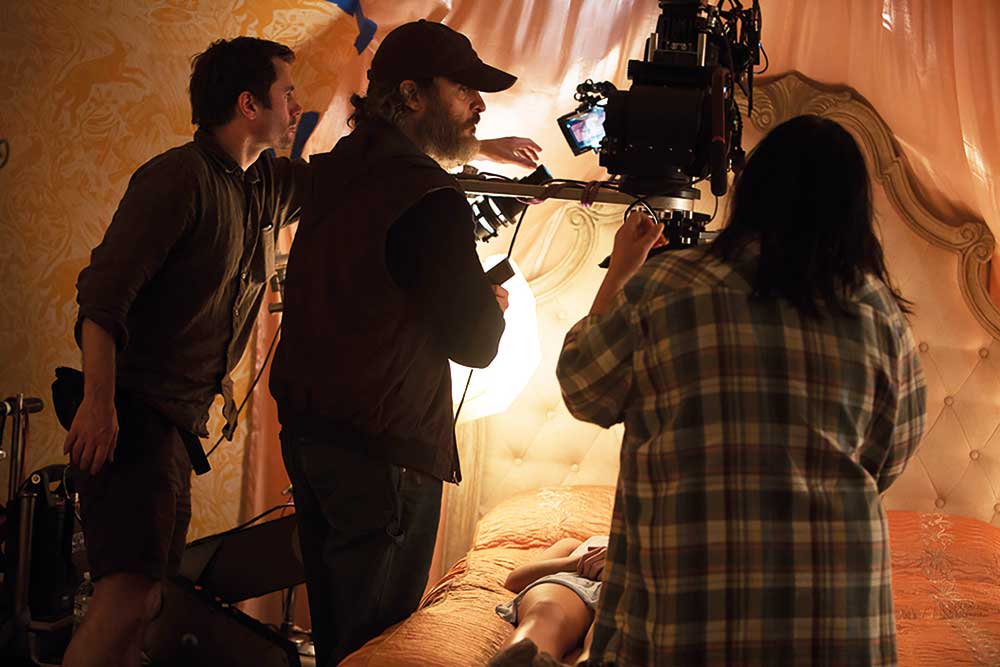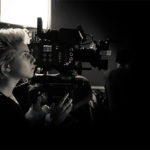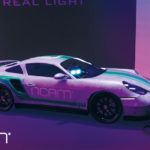
In Plain Sight
Posted on Jul 17, 2018 by Julian Mitchell
 Joaquin Phoenix showed admirable lack of vanity, and was not concerned by how he was lit.
Joaquin Phoenix showed admirable lack of vanity, and was not concerned by how he was lit.
It’s a testament to the creatives involved in You Were Never Really Here that a warped time frame produced such a great looking film
Words Julian Mitchell
Not the most prolific director, Lynne Ramsay last made a full-length movie in 2011 (the horror-parenting film We Need to Talk About Kevin). Back then the gear list almost encapsulated the period setting with Panaflex Millenium and Platinum film cameras with C and E series lenses, and an appearance from Canon’s 5D Mk II DSLR, which was the digital camera of the moment. Her and DOP Tom Townend’s initial feeling for You Were Never Really Here was 35mm and anamorphic lenses – that’s until the accountant got involved and the ARRI Alexa, with a myriad of glass, became the more affordable choice.
“I wanted to persuade Lynne that digital could easily emulate film and the only difference between the two was that the camera wouldn’t have a mag of film on the top of it.” That film-to-digital-conversion conversation was commonplace around five years ago, but Tom still fields the ‘I want to make it look like film’ question all the time when shooting on digital. However, Tom reckons that digital is 80% of what he shoots now.
“Lynne was resistant to the idea initially because it was not what she was used to. We actually shot a test on Kodak 500T film alongside the Alexa, day and night, just on a street corner and took that into a grading suite to really prove that the look of 35mm could be emulated, and we added grain as well. That satisfied Lynne and I promised her there was no difference in working practice. As it happened, of course you don’t have to re-load every ten minutes and the camera will keep on rolling, something that she really embraced. It suited her and Joaquin Phoenix to shoot without interruption just to see what would happen. I think she mildly regretted it when she came to the edit. If she’d had the discipline of film imposed on her the natural breaks would’ve come with that.
 Judith Roberts shares a scene with her screen son Joe (Phoenix).
Judith Roberts shares a scene with her screen son Joe (Phoenix).
“From my point of view I don’t treat them differently from each other, I meter everything, but interestingly 800 ASA on a light meter does not automatically translate into the correct exposure as it should be on the Alexa. Why that is I don’t know. It’s a guide at any rate. We only ever had one monitor on set which was Lynne’s and my monitor, and I would occasionally look just for some sort of assurance of what it was we were shooting.
“The ARRI Alexa was a budgetary decision that was foisted on us from on high. The production happened very quickly so there weren’t many decisions made on the look we wanted. I’ve known Lynne for twenty years, in fact she was leaving film school just when I was joining. In no time at all we were scouting for locations so in a way the discussion was not so much about a look but more about, does this location work for both our needs? There was no obvious reference film we both wanted to emulate, it just kind of happened, and it happened so quickly that there wasn’t time to do the usual navel gazing as you usually do in big productions. I think this had to do with how well Lynne and I know each other.” The quickness of the production decisions were down to lead actor Joaquin Phoenix, who initially couldn’t do the movie but then had a hole in his schedule – only if the film could start almost immediately.
The novella the film is based on describes Phoenix’s character as someone who is hiding in plain sight, looking completely anonymous and blending in with his surroundings. “When you’re filming someone walking along the street they’re obviously the focus of the shot and there is no real way of making them blend in with their surroundings, and I guess an equivalent of that is to keep them in shadow. One of the really liberating things was having a lead actor who doesn’t really have any vanity. There was never a question of presenting him in his best light, he simply didn’t care. A lot of the time Lynne encouraged the fact that his face would be in shadow, it would help the story as you wouldn’t know what was going on with the guy.”
Happy ‘location’ accidents
The film was around 90% location shooting; the only builds had to do with tax relief. “They were a couple of builds, which was one way of accessing the tax break money that New York offers if you occupy stage space for two days out of your production. As it happened there were a couple of scenes that it made sense to build rather than to look for a location.
“A fair portion of the film is night exterior and that look was further dictated by what resources we had. We had to go with what was there and then build on that. It was really a case of finding a location and seeing if it worked. For instance, there was an office location on the second floor of this building and we knew that we wouldn’t be able to light through the windows, so it became a scheduling issue more than anything else – could we guarantee we would be able to shoot the scene during certain hours of the day and not get stuffed by the sun going down, things like that. So it was all kind of pragmatic, but there were happy accidents along the way – there’s a scene in a spa, and when we first went to look at it we knew we needed a single light bulb (in the script it described a single light bulb dissolving through to a midday sun in another location). When we got there it was indeed a single light bulb, but it was one of those super blue energy-saving light bulbs. We liked the fact that a sauna or spa was a very intense, cold blue colour; we liked the fact that it was not what you’d expect. When we shot there we just added blue lighting, which was fun to do.”
 Night shoots took advantage of New York’s potentially tricky ambient light.
Night shoots took advantage of New York’s potentially tricky ambient light.
Night scenes in a 24-hour city like New York are always going to be difficult to shoot with the high ambient light spillage, but then perhaps useful to avoid noise from pushing the sensor. “I never went above 1280 ISO but that was really just to get a healthier stop. I had no desire to shoot anamorphic to really test the mettle of the focus department. If I gave them a 2.8/4 split at night, that seemed a better bet than shooting wide open. A lot of the lenses we were using just wouldn’t perform at below 2.8 anyway.
“It was an alphabet soup of lens choices. Panavision Anamorphic lenses with a mixture of C-series, a couple of E-series and then AL Series. It wasn’t a huge set of lenses but we carried two 50mm and a couple of 75mm lenses, only because the C series in those focal lengths have nice characteristic and flare. But the ALs, which were much bigger and heavier, didn’t have any of the slight aberrations or slightly weird focus drop-offs across the frame. Depending on the situation, I would go for the well-behaved lens or the ill-disciplined one.”
 Most of the movie was filmed on location, with built sets used for a couple of interiors.
Most of the movie was filmed on location, with built sets used for a couple of interiors.
Tom’s locations sometimes didn’t help with close focus on the anamorphics but he used a 55mm macro lens – it was even inscribed on the lens that it was ‘eye focus only’, as in ‘don’t trust the focus scale’. “That was an invaluable lens on certain occasions when we wanted to be close but also relatively wide angle.”
Camera movement
Tom’s usual mode of transport for his camera is a dolly, even if he’s only using it as a tripod substitute, mainly as it’s so much easier to adjust the height. In fact, the first AD on the shoot named Tom’s type of camera movement as ‘heavy camera’. “This mainly meant that it was pretty firmly bolted to the ground for most of the time and it only ever panned if it needed to. That was sort of the style just because Lynne isn’t a fan of hugely choreographed shots, and also just the way the scenes were played out. It didn’t make much sense to plan anything elaborate because things would change on the day. There are a couple of Steadicam shots and a couple of handheld shots but that’s about it. We did have a 30-foot Technocrane locked off but it was the only way to get the camera in to its position, as we had to go over the property of someone who wouldn’t give us a permit. We just parked the base of the crane in a backyard and hoisted the camera over.”
The movie is very light on dialogue scenes and so builds the narrative with the visuals. For a DOP this can be good news as you’re not setting up return shots, which take time. “It was a quiet set most of the time – you could only have the lead actor in the room, quite often you’d set a frame and then see what would happen.”
 Ekaterina Samsonov plays Nina, who becomes a key part of Joe’s story
Ekaterina Samsonov plays Nina, who becomes a key part of Joe’s story
The lighting design didn’t call for any type of separate design for Joaquin, partly because of his lack of vanity. Tom would start with where the light would naturally be coming from, which is easy when you have windows but didn’t help when people decided to have their backs to those windows, “Even then I would try and make it realistic, I didn’t use any filtration at all and there was no great need with the lenses we used. Some of the flaring actually acts as its own diffusion. Having someone who is not concerned with how they’re being lit is pretty liberating because it meant I could bounce light off the floor to get it in to his face, which some people would object to but in this instance nobody was complaining. Also there was no imperative to always see the actor’s eyes or have an eye-light or anything like that. But we had the usual tools, so if you needed a single source coming through the windows we would have an 18K and bounce it off an Ultra Bounce or something like that. I did try to keep the lamps out of the room as much as possible, just because they would disturb the spirit of the set a little bit. Also, they were pretty small rooms most of the time so you’d run out of elbow room fairly quickly.
Grading timeline
With actor Joaquin Phoenix suddenly being available, the film’s scheduling brought it into the realm of a showing at Cannes – that meant a grade at quite short notice (an understatement really, as there were still two days’ worth of shooting left before the grade even started). “Some scenes had deliberately not been shot in principle photography – they were the underwater scenes, as there was no tank facility in New York, and a couple of other scenes where Joaquin didn’t have a beard, which he had grown for a subsequent role. Lynne also wanted to work with Jean-Clement Soret at Technicolor as she had worked with him before, in fact that project was the only time she had experienced digital grading. Jean-Clement was available for five days and that was just before it was scheduled to go to Cannes with the edit still being fiddled with, and unfortunately I was away. So I ended up spending a day with Jean-Clement when we literally just went through the whole film, and would stop occasionally with me making a comment about the general look of any location, whether it should be a little bit darker, colder, that kind of thing. Pretty much ‘old school’ photo-chemical printing terminology, nothing to do with secondary power windows or anything like that.”
 Lynne Ramsay (director) and Tom work through creative decisions on set.
Lynne Ramsay (director) and Tom work through creative decisions on set.
Tom had worked with Jean-Clement many times anyway, so he wasn’t worried about what he could or couldn’t achieve. After Cannes, Tom and Jean-Clement went back to the film for another two days, “but at that point everyone had settled in to the look so there was no feeling to change much. I have to say that it doesn’t look hugely different from the dailies, but that’s doing Jean-Clement a disservice as it makes it sound like he didn’t do anything, which isn’t true at all because of course there’s a huge amount of incredibly subtle balancing going on, especially when a sequence is cut and also just with the nature of the lenses we were using, changing from one focal length to another – you get different colours and different contrast values. All those little things really need to be ironed out, and I was more than happy to leave him to his own devices in that respect.”
For Technicolor’s Jean-Clement, his first, pre-Cannes meeting covered balancing events such as lighting on location. “Sometimes you are caught out by the lack of light, or too much light. I reassured Tom that I could help or disguise that. After the film came back from Cannes it was a luxury to revisit it with Lynne and be able to change my mind about scenes. We changed a bit on the black and white sequence, adding more grain and pulsing to the camera, which Lynne supported and Tom explained how realistic that could be.”
As Tom had mentioned earlier, Lynne was surprised how close they could get to a film look having shot digitally. “I have graded thousands of projects, including film, and I could give her something as if she had been shooting on film. That really comes with experience, and if you’re careful not to crush blacks and keep highlights soft – some of the characteristic of film. Also how you reintroduce grain is of great importance: for instance, grain in the highlights is slightly more yellow and grain in the low lights is slightly more blue. You can then really fool your audience that the film was shot on film.
 The film contains little dialogue, so visuals did much of the heavy lifting.
The film contains little dialogue, so visuals did much of the heavy lifting.
“The minute Tom and Lynne came in to the room they said that they had wanted to shoot on film but weren’t able to, so that was the brief. Interestingly, that request is something I hear a lot, still. But I think it depends on the projects. I work in advertising a lot and some projects which are sharp and high-tech embrace the digital look; people who perhaps want more warmth and humanity usually choose the film look, and sometimes look to degrade the image to achieve that.”
With some movies taking six weeks to grade, having two weeks really demanded that the group of creatives realised, from day one, what they wanted. This was the case with You Were Never Really Here, Jean-Clement again: “Lynne and Tom knew exactly what they wanted and came straight to the point, which is just the opposite to the advertising world where you need to see everything as you’ve only got 30 seconds, so need maximum impact.
“The grade didn’t major on the power window-type work but there was a little tracking for stabilisation purposes; with a two-week window you have to tailor what you can do in post. Normally, you set the look for the first two weeks then adjust the details for the rest of the process.”








